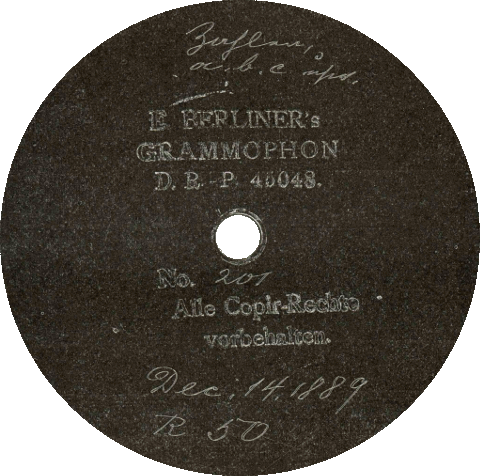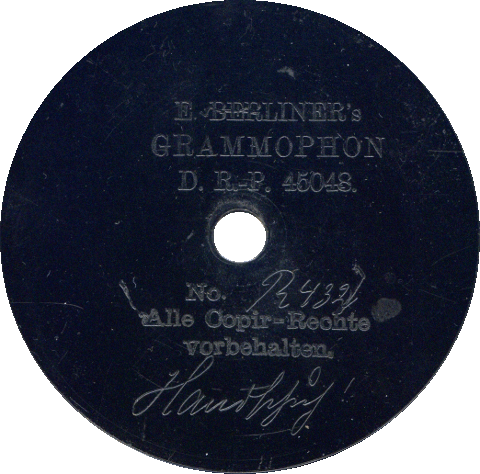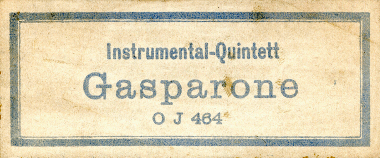by Stephan Puille, Berlin, Germany

Version 01 October 2018
Licensing by Norman Bruderhofer
Publisher for Phonographic Subjects

Supplemented version of the article by Stephan Puille, first published in: Pekka Gronow; Christiane Hofer (eds.) The Lindström Project.: Contributions to the History of the Record Industry/ Beiträge zur Geschichte der Schallplattenindustrie, Vol. 10, Vienna, Gesellschaft für historische Tonträger e.V., 2018, pp. 5-11. There is a general consensus that the first commercial disc records were manufactured and marketed in Germany. In June 2015, I found the last missing part of the puzzle: a copy of the contract, long thought lost, between Emile Berliner and German investors to put the gramophone on the market. Even after this find, essential questions concerning the identification of the earliest pressings, the quantity of issued titles and the numbering system still remained unanswered. After being able to clarify some issues and hopefully coming closer to the historical truth, I have decided to present my findings from thirty years of research on 12.5 cm (4.92 inches) Berliner discs, often incorrectly referred to as 5 inch Berliner / 5" Berliner records. Of vital importance has been the gathering of information from, up to the present, 286 hard rubber discs and a handful each of celluloid pressings, zinc masters and nickel-plated copper stampers of 162 different recordings. After evaluating many potentially important factors, I felt safe enough to identify 55 pressings of 33 recordings as the first commercial disc records in the world (see figure 2 and table 2 below). I would like to express my thanks to Peter Adamson, Christian Büchele, Henri Chamoux, Paul Cleary, Patrick Feaster, David Giovannoni, Klas Häggström, Johannes Kapeller, George Paul, George Taylor † and several other private collectors and employees of public archives, who supported me with valuable information. Historical background On April 25, 1890, through the negotiation and with the participation of entrepreneur Albert Flürscheim of Frankfurt on the Main, the small company Kämmer & Reinhardt, founded by Ernst Kämmer and Franz Reinhardt in 1885 in Waltershausen, Thuringia, concluded a license agreementi with Emile Berliner. The inventor of the gramophone had been living in his hometown of Hanover for seven months, having arrived there with his family on September 11, 1889. The licensees Flürscheim and Kämmer & Reinhardt were contractually obliged to found the open trading company Grammophon Spielwarenfabrik Kämmer, Reinhardt & Co. with its registered office in Waltershausen, but Spielwaren (toys) was dropped from the company's name before the commencement of business. Emile Berliner thus sold the exclusive marketing rights to his gramophone patent - except for installation in watches. The contract was limited to three years from July 1, 1890 and included the whole world, with the exception of the United States of America and Canada. Only discs with a maximum diameter of 4.92 inches (125 millimeters) were allowed to be produced. The contract required that the records have a maximum diameter of 12.5 cm and that the gramophones, mass produced in the Grammophon-Fabrik Kämmer, Reinhardt & Co., be configured preferably in such a way that playing larger sizes of records is hampered. Berliner undertook to loan three large recording gramophones, which were to be exchanged for smaller ones after six months. Berliner was obligated to spend at least three weeks in Waltershausen before August 1, 1890, in order to provide the licensees with all "details and tricks of fabrication"ii of gramophones, cylinders (!) and discs. The license agreement furthermore required that sound boxes and recordings state the patent number of the local market they were intended for. For Germany, therefore, the inscription "E. Berliner's Grammophon DRP 45048" was prescribed. Production specifications Both celluloid and hard rubber were tested for their suitability as pressing material during the first half of 1890. The choice fell upon celluloid first, perhaps for reasons of cost, but the output was extremely limited. Only three of these celluloid discs have come to light, one of these unnumbered. I believe all three were once in the possession of Emile Berliner, who probably took them back to the United States of America when he left Germany in late August or early September 1890.iii Berliner celluloid discs are easily distinguishable by their light yellow color, which makes the reading of the label very difficult. One specimen I have examined, numbered N 104, is about 0.15 cm (0.06 of an inch) thick and 12 cm (4.72 inches) in diameter. The reverse side bears fine, parallel grooves, evidently caused by the calender during the manufacturing process. Emile Berliner had little contact with the licensees after the fulfillment of his contractual obligations. Thus, the inventor assumed for several months that only celluloid was being used, but his knowledge was not up-to-date, especially since Kämmer, Reinhardt & Co. did not send him copies of the first marketed discs.iv My impression is that the first commercial discs worldwide, delivered to the trade from early September 1890,v were pressed from both materials, celluloid and hard rubber. But while the former was quickly abandoned, hard rubber remained in use until the expiration of the contract on June 30, 1893. It simply proved to be "much more durable and more suitable for the intended purpose."vi About 25,000 records were manufactured exclusively by the Rheinische Gummi- und Celluloidfabrik in Mannheim-Neckarau, Baden-Wuerttemberg, which cost the Thuringian licensees approximately 30 Pfennig (US $0.07) each.vii Pressing material of the good quality required was expensive. The hard rubber 12.5 cm Berliner discs were deep black and shiny and only about 0.1 cm (0.04 of an inch) thin, which made them sensitive to mechanical and thermal exposure. In July 1890, Kämmer, Reinhardt & Co. determined an ex-factory price of 40 Mark (US $9.40) per gramophone and 1 Mark (US $0.24) per record. Graduated discounts were granted for larger quantities.viii During the early 1890s, gramophones from Waltershausen were the only sound reproduction devices that reached the free market in noticeable numbers. They were offered in Germany not as toys but as a serious entertainment medium. Gramophone dolls with unnumbered miniature discs of 7.6 cm (3 inches) size, were projected from the very beginning of the license agreement, but did not reach the public until 1895.ix One observation may allow us to draw some conclusions as to the number of pressed copies: On a seemingly original, numbered record bag holding its respective metal stamper,x a quantity of 12 units (“12 Stück") was noted. A similar note on another record bag lists 6 and 12 units. The note of 12 units was crossed out. Three further bags were unmarked. It seems that Kämmer, Reinhardt & Co.-renamed Kämmer & Co. in 1891-ordered pressings at least for some time either by the dozen or by the half dozen.  Fig. 1: Intaglio print of zinc master number 201 Zahlen, a,b,c usw., mirrored for better readability. © by Stephan Puille Label design During the production period several label varieties were added. I define "label" as the etched, engraved or stamped information in the center portion of the disc. The smooth reverse side offered space for a glued paper slip with information as to number, title and content (see figure 3). In autumn 1889, Emile Berliner recorded a number of zinc masters for the first public performances of his invention in January 1890 in Berlin. Negotiations for marketing the gramophone were already underway but far from completion. Of highest importance for discographers is the intaglio print of a disc from that period, dated December 14, 1889 on the record label (see figure 1). The zinc master was used as a printing plate. The mirrored print in original size was issued as an illustration in a weekly journal.xi By direct comparison of the intaglio print with the first commercial pressings (see figure 2), it becomes apparent that the label design was already matured in December 1889. "E. BERLINER's GRAMMOPHON" in capital letters and "D. R. - P. 45048", the number of the German main patent, appear above the spindle hole. Prominently positioned near the label center, a blank line marked with the abbreviation "No." was used for individual numbering. In this case, "201" was inscribed in a clearly visible manner. This is followed by a copyright notice in German: “Alle Copir-Rechte vorbehalten." The blank part of the label provided space for the handwritten record title and other details. The specification of recording date, location and speed, “R 50" for 50 revolutions per minute in this case, appears only in rare cases. The recording speed was normalized to 100 revolutions per minute, a figure that was more or less maintained on standard 12.5 cm Berliner discs.xii The performer was never mentioned.  Listen to an excerpt [Unknown performer, clearly not Emile Berliner himself]: [Transcription:] Vor seinem Löwengarten, Das Kampfspiel zu erwarten, Saß König Franz, Und um ihn die Großen der Krone, Und rings auf hohem Balkone (Die) Damen in schönem Kranz. Fig. 2: Hard rubber pressing of number R 432 Handschuh as a typical example of the first commercial discs. Image © by Stephan Puille, Sound transfer by Norman Bruderhofer Numbering system The importance of distinguishing among inscribed and stamped numbers on 12.5 cm Berliner discs for identification and differentiation has heretofore been overlooked. As a result, current discographies indiscriminately mix several non-compatible numbering systems, introduced from 1889 onwards. Inscribed numbers have nearly always been ignored in the presence of stamped numbers, which makes the matter worse and has complicated data collection. In my present article, I am concentrating on the first numbering system with inscribed numbers. Record catalogues from that period have not been found. For the sake of simplicity, I will list all numbers known to me in tabular form in sequential order (see table 1 below). The stamped numbers of later numbering systems, as far as they could be secured from stampers, pressings and catalogue entries, are listed in brackets in the right column of table 1. From this it becomes clear that most of the issued recordings with inscribed numbers of the first numbering system have been re-pressed at least one or two times. The lowest inscribed number detected by me thus far is 27, the highest 1290. Emile Berliner's voice can be heard on several records throughout the entire number range. I conclude that the first numbering system was introduced and in use during Berliner's stay in Germany between September 1889 and August 1890. Almost every known disc from that period is distinctively numbered in consecutive order. Since overlaps did not occur, one must assume that there was some kind of recording book. Perhaps it is possible to create a chronology. Put simply, the lower the inscribed number, the earlier the recording date. With the switch to stamped catalogue numbers, introduced most likely at an unknown date in 1891, the system of inscribed numbers became obsolete. As a consequence, numbers from the former system were sometimes made illegible either on the metal stamper or, if the recording had been held back in the archive, on the zinc master. After receiving an updated catalogue number and a new nickel plating, many stampers were reused. Fortunately, on many such re-pressings, the inscribed number survived side by side with the stamped number. In this way, it could still be evaluated and included in table 1. In such cases, however, the re-pressing is not included in table 2, where I have only listed the earliest commercial discs. On some discs, the inscribed and stamped numbers are identical. That did not happen accidentally. I am convinced that such recordings stem from a time of transition between the first and the second numbering system. Thus, they cannot belong to the earliest recordings and I didn't include them either in table 1 or in table 2. The same applies to a few recordings with inscribed numbers but a different label design for foreign markets, such as England and France. As far as I know, Kämmer, Reinhardt & Co. established business relations outside Germany starting in late 1890, only then creating the need of respective label designs following their contract.xiii  Fig. 3:Paper slip, glued on the reverse side of number QI 464 Gasparone. Note the different prefix “OI". Remark: In the Fraktur script, in use until the beginning of the 20th century in German-speaking countries, the capital letters "I" and "J" usually had the same typeface. Image © by Stephan Puille Assignment of classes On many recordings, the inscribed number is augmented by the assignment of classes (“Klassen"), which were placed before or after the disc number in abbreviated form as a prefix or suffix to provide additional information. Appearing only sporadically below number 304, it was added regularly thereafter but vanished completely from number 1200. A sizable number of classes were foreseen,xiv but only the following have been detected on pressings. B Bass, Bariton Ch Chor (Choir) Cl Klarinetten-Solo (Clarinet) N (Unknown; perhaps an abbreviation of “Number") Nt Naturstimmen (Sounds of Nature) Or Orchester P Piano-Solo PS Posaunen-Solo (Trombone) Ps Piston-Solo/Piston-Kornett-Solo (Cornet) QI Instrumental-Quintett Qt I Instrumental-Quartett (-Quintett?) R Recitation Tl Trommel (Drums) Tn Tenor T.Qu. Trompeten-Quartett (Trumpet Quartet) General overview of recordings made between September 1889 and August 1890 (Table 1) With great likelihood between September 1889 and August 1890, that is during Emile Berliner's stay in Germany, roughly 1300 gramophone recordings were made. Not necessarily all by the inventor, but he certainly had a good share in it. The general overview in table 1 lists these recordings in order of their numbering with inscribed numbers of the first catalogue system. These data were taken from masters, stampers, pressings and printed materials. Stamped numbers of later catalogue systems, if they could be detected on (re-)pressings, are listed in brackets. Of course, in the early 1890s, many more recordings were made for the Kämmer, Reinhardt & Co., respectively Kämmer & Co., gramophone and I collect all available information about them. However, since the topic of my article are the world's first commercial discs, for which these later recordings don't qualify, they are consequently missing from the following lists. Table 1, displaying my present state of knowledge after thirty years of data collecting, shows large gaps in the sequence of numbers. Even if I add those which are not listed here because their number was made illegible, or which remained unnumbered from the beginning, only about 90 recordings are known to me. That's only 7 percent of the initial number. Really a meager yield. One can speculate about the reasons, but there is not enough space within the scope of my article.
Listing of the earliest commercial disc record pressings (Table 2) So far I have identified 55 pressings of 33 recordings as the earliest surviving commercial disc records. This is a little less than 20 percent of the total number of 12.5 cm Berliner pressings known to me. The common feature is that these discs solely carry the inscribed number of the first catalogue system, in use at the sales launch in September 1890.
Endnotes ii Ibid. „Einzelheiten und Kunstgriffe der Fabrikation“ iii Emile Berliner donated celluloid disc numbered N 104 to Deutsches Museum München in 1906; the other two, designated Tn 306 and Qt I, are kept in the Library of Congress Robert Sanders Collection, 1990 iv Emile Berliner, The Improved Gramophone, Paper Read at the 52nd Meeting of the American Institute of Electrical Engineers, New York, 16 December 1890, n.p. v Otto N. Witt ed., Prometheus. Illustrirte Wochenschrift über die Fortschritte der Angewandten Naturwissenschaften, Vol. 1, No. 48, Berlin 1890, pp. 766-767. Only dated by year, but certainly early September 1890 vi Otto N. Witt ed., Prometheus, Illustrirte Wochenschrift über die Fortschritte der Angewandten Naturwissenschaften, Vol. 2, No. 72, Berlin 18 February 1891, pp. 308-310. „[…] als wesentlich dauerhafter und für den gedachten Zweck geeigneter.“ vii Emile Berliner to William Barry Owen, 23 December 1897 EMI Collection viii Grammophon-Fabrik Kämmer, Reinhardt & Co., Pamphlet, July 1890, n.p. Library of Congress Manuscript Division ix George F. Paul, Stephan Puille, Phonography, The Kämmer & Reinhardt Gramophone Talking Doll, in: The Sound Box, Vol. 28, No. 2, Victorville, USA, June 2010, pp. 3-7 xi Otto N. Witt ed., Prometheus. Illustrirte Wochenschrift über die Fortschritte der Angewandten Naturwissenschaften, Vol. 1, No. 14, Berlin 1890, p. 212. Only dated by year, but certainly early January 1890 xii Technische Notizen über den Gebrauch des Grammophon-Aufnahme-Apparats, Pamphlet, July 1890, n.p. Library of Congress Manuscript Division xiii In October 1890, Albert Flürscheim visited London to demonstrate the gramophone and to sell the English marketing rights. Elektrotechnische Zeitschrift, Vol. 11, No. 44, 31 October 1890, p. 583 xiv Patrick Feaster, Stephan Puille, E. Berliner's Grammophon, The Beginning of the German Talking Machine Industry, Part 4, in: The Sound Box, Vol. 29, No. 3, Victorville, USA, September 2011, pp. 6-7 |
© 2018 by Stephan Puille
Published by Verlag Norman Bruderhofer
für phonographische Themenbereiche